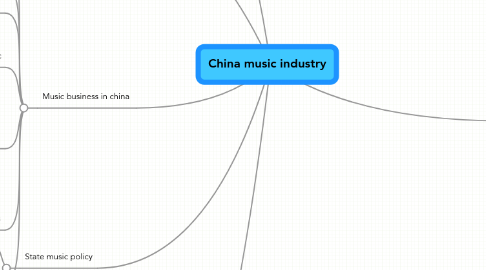
1. Market structure
1.1. Demographics
1.1.1. Have about 20 percent of the world's population
1.1.2. Twenty-five years ago, the Communist Government of China instituted a policy of one child per family as a means of curtailing population growth
1.1.3. 15–29: 22.8% ,30–44: 26.7%
1.2. Education
1.2.1. education sector expected to reach 4 percent of GDP by 2010.
1.3. Economy
1.3.1. second largest in the world after the US with a GDP of $10.21 trillion
2. Music business in china
2.1. repertuar
2.1.1. International 78%
2.1.2. Domestic 13%
2.2. legal music market in China accounts for just $76m (£38m)
2.3. Concerts
2.3.1. U2, Madonna, Led Zeppelin, Aerosmith, ZZ Top, Lionel Richie, Celine Dion, INXS, Velvet Revolver, Will I. Am, Justin Timberlake, and Timbaland, ( by WP1 founder Doug Ivanovich) in China World Peace Concerts
2.4. Mobile music
2.4.1. Single song was downloaded 15 million times over China Mobile's network in the last six months, a rate 15 times higher than a typical best-selling music CD".
2.4.2. CMCC, is the largest mobile phone operator in China. It is the world's largest mobile phone operator ranked by number of subscribers, with over 376.38 million customers
2.4.3. Sony BMG Music with Global Music International to distribute the company's music videos, full track songs and ringtones to mobile subscribers in China.
2.5. Piracy issues
2.5.1. 99% of all music files in China are pirated
2.5.2. (IFPI) said that it, Warner, Sony BMG and Universal have all filed suits against Baidu, Sohu and a company associated with it, Sogou.
2.5.3. Baidu is largest digital music distributor in the country
2.6. Downloads
2.6.1. Google is reported to be finalising plans to provide free licensed music downloads in China
2.6.2. (IFPI) has announced a renewed legal assault on several companies, including Baidu and Yahoo China, which it alleges are "committing mass copyright infringement".
2.6.3. Baidu dominates China's search market, with a share approaching 70 per cent compared to about 20 per cent for Google.
2.7. Music and its influences
2.7.1. Chinese music was strongly influenced by foreign music, especially that of Central Asia
3. Deals
4. Genres and artists
4.1. Record labels
4.1.1. • EMI - Push Sound; Sony BMG- Shanghai Audio and Visual Press; Universal Music l- Shanghai Media Group Warner Music Group- Warner Music China.
4.1.2. Terra Firma, , announced in January it would try more direct band sponsorship
4.1.3. Universal Music China, is optimistic about growth in western music sales. UMC will release 40 per cent more international titles this year - bringing it to roughly 100 albums
4.2. Artists
4.2.1. Gao Feng
4.2.1.1. Popular song: Da Zhongguo
4.2.2. Chinese rock and roll singer, now turned jazz musician, Cui Jian
4.2.3. Solo artists
4.2.3.1. Chi Zhiqiang Cui Jian Dou Wei Gao Qi He Yong Liu Yijun (aka Tang Chao Laowu) Tian Zhen Wan Xiaoli Wang Feng Wang Lei Xu Wei Xue Cun Zhang Chu Zang Tianshuo Zheng Jun Zuoxiao Zuzhou
4.2.4. Some of bands
4.2.4.1. Ashura Again AK-47 Anodized Baboo Black Box Black Panther Brain Failure Carsick Cars Cavesluts CLIMAX Cobra ( Cold Blooded Animals Cold Fairyland Confucius Says Dzap Dau Dau
4.3. Genres
4.3.1. Rock
4.3.1.1. alternative music in China today is much like Western rock in the 1960s, rock is rarely heard on the radio
4.3.1.2. Rock enjoyed a wave of popularity in China the early 1990
4.3.1.3. Decline of Rock (1994)
4.3.1.4. important step in the development of Chinese rock music had been the Beijing Midi School of Music in Beijing
4.3.2. Rock'n' roll
4.3.2.1. Rock ’n’ roll is mostly limited to special programs that are allowed brief windows of airtime.
4.3.2.2. Birth of Chinese rock and roll (1989)
4.3.3. C-Pop
4.3.3.1. Most of today's c-pop artists originate from Hong Kong, Taiwan, and mainland China. Others come from countries where the Chinese language is used by a large number of the population, such as Singapore and Malaysia.
4.3.4. Hip-Hop
4.3.4.1. Chinese hip hop has started to come to its own in the 2000s.
5. State music policy
5.1. Organizations
5.1.1. China Music Instrument Association (CMIA
5.1.2. KHS Musical Instrument Co
5.1.3. New Central Music Co
5.2. Radio
5.2.1. ew radio stations need approval, and regulators would consider whether the content fits with social trends and national policy
5.2.2. Mandarin Radio
6. Links
6.1. MTV in China http://www-scd.univ-lyon3.fr/externe/lee/lee_gaofeng.htm
6.2. Industry against piracy http://www.ifpi.org/content/section_news/20080204.html
6.2.1. Recording industry http://inderscience.blogspot.com/2007/09/call-for-papers-chinese-recording.html
